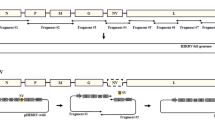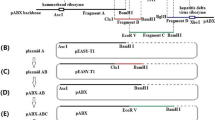Abstract
Nervous necrosis virus (NNV), one of the most prevalent fish pathogens, has caused significant losses in both yield and economy to the aquaculture. Host factors involved in NNV infection remain to be identified due to the lack of ideal model for the study of NNV and host interaction. Haploid stem cells have proven to be ideal materials in genetic screens. Here, we generated a cell line HX1G1 (simply named G1) with the activity against red-spotted grouper nervous necrosis virus (RGNNV) by N-ethyl-N-nitrosourea (ENU)-mediated whole genome random mutagenesis from the haploid embryonic stem cell HX1a, a cell clone from haploid cell line HX1 that we previously derived from the medaka fish. G1 cells retained the characteristics of haploidy and pluripotency as indicated by the EBs differentiation ability after genetic mutagenesis. Compared with HX1a cells, no typical cytopathic effects were observed, and the expression of RNA-dependent RNA polymerase (RDRP) was significantly reduced in G1 cells post RGNNV infection, indicating the enhanced anti-RGNNV activity of G1. Furthermore, we demonstrated that RGNNV entry into G1 cells was partially inhibited, and this inhibition might be relevant to the induced mutation of heat shock cognate protein 70 (HSC70) which was decisive for NNV entry. Interestingly, G1 cells were to some extent permissive to RGNNV infection, but RGNNV was spontaneously cleared in G1 cells during serial passage. In addition, we also found that the expression levels of interferon (IFN)-related genes were higher in G1 cells than those in HX1a cells, suggesting that viral clearance might be associated with the elevated expression of IFN-related genes in G1 cells.







Similar content being viewed by others
References
Aydin Y, Chatterjee A, Chandra PK, Chava S, Chen W, Tandon A, Dash A, Chedid M, Moehlen MW, Regenstein F, Balart LA, Cohen A, Lu H, Wu T, Dash S (2017) Interferon-alpha-induced hepatitis C virus clearance restores p53 tumor suppressor more than direct-acting antivirals. Hepatol Commun 1:256–269
Béjar J, Hong Y, Schartl M (2003) Mitf expression is sufficient to direct differentiation of medaka blastula derived stem cells to melanocytes. Development 130:6545–6553
Bull KR, Rimmer AJ, Siggs OM, Miosge LA, Roots CM, Enders A, Bertram EM, Crockford TL, Whittle B, Potter PK, Simon MM, Mallon AM, Brown SDM, Beutler B, Goodnow CC, Lunter G, Cornall RJ (2013) Unlocking the bottleneck in forward genetics using whole-genome sequencing and identity by descent to isolate causative mutations. PLoS Genet 9:e1003219
Caignard G, Eva MM, van Bruggen R, Eveleigh R, Bourque G, Malo D, Gros P, Vidal SM (2014) Mouse ENU mutagenesis to enderstand immunity to infection: methods, selected examples, and perspectives. Genes 5:887–925
Chang JS, Chi SC (2015) GHSC70 is involved in the cellular entry of nervous necrosis virus. J Virol 89:61–70
Chisada S, Okamoto H, Taniguchi Y, Kimori Y, Toyoda A, Sakaki Y, Takeda S, Yoshiura Y (2011) Myostatin-deficient medaka exhibit a double-muscling phenotype with hyperplasia and hypertrophy, which occur sequentially during post-hatch development. Dev Biol 359:82–94
Choe J, Lee SM, Lim S, Choi SH, Kim N, Do K-H, Seo JB (2017) Doubling time of thymic epithelial tumours on CT: correlation with histological subtype. Eur Radiol 27:4030–4036
Costa JZ, Thompson KD (2016) Understanding the interaction between Betanodavirus and its host for the development of prophylactic measures for viral encephalopathy and retinopathy. Fish Shellfish Immunol 53:35–49
Dong C, Shuang F, Weng S, He J (2014) Cloning of a new fibroblast cell line from an early primary culture from mandarin fish (Siniperca chuatsi) fry for efficient proliferation of megalocytiviruses. Cytotechnology 66:883–890
Hai T, Guo W, Yao J, Cao C, Luo A, Qi M, Wang X, Wang X, Huang J, Zhang Y, Zhang H, Wang D, Shang H, Hong Q, Zhang R, Jia Q, Zheng Q, Qin G, Li Y, Zhang T, Jin W, Chen ZY, Wang H, Zhou Q, Meng A, Wei H, Yang S, Zhao J (2017) Creation of miniature pig model of human Waardenburg syndrome type 2A by ENU mutagenesis. Hum Genet 136:1463–1475
Hoebe K, Beutler B (2005) Unraveling innate immunity using large scale N-ethyl-N-nitrosourea mutagenesis. Tissue Antigens 65:395–401
Hong Y, Winkler C, Schartl M (1996) Pluripotency and differentiation of embryonic stem cell lines from the medakafish (Oryzias latipes). Mech Dev 60:33–44
Hong Y, Chen S, Gui J, Schartl M (2004) Retention of the developmental pluripotency in medaka embryonic stem cells after gene transfer and long-term drug selection for gene targeting in fish. Transgenic Res 13:41–50
Huang X, Huang Y, Cai J, Wei S, Ouyang Z, Qin Q (2013) Molecular cloning, expression and functional analysis of ISG15 in orange-spotted grouper, Epinephelus coioides. Fish Shellfish Immunol 34:1094–1102
Huang R, Zhu G, Zhang J, Lai Y, Xu Y, He J, Xie J (2017) Betanodavirus-like particles enter host cells via clathrin-mediated endocytosis in a cholesterol-, pH- and cytoskeleton-dependent manner. Vet Res 48:8–24
Janiak M, Caraballo Cortes K, Demkow U, Radkowski M (2018) Spontaneous elimination of hepatitis C virus infection. Adv Exp Med Biol 1039:45–54
Jia P, Jia KT, Yi MS (2015) Complete genome sequence of a fish nervous necrosis virus isolated from sea perch (Lateolabrax japonicus) in China. Genome Announc 3:e00048–e00015
Le Y, Li Y, Jin Y, Jia P, Jia K, Yi M (2017) Establishment and characterization of a brain cell line from sea perch, Lateolabrax japonicus. In Vitro Cell Dev Biol Anim 53:834–840
Liu W, Hsu CH, Hong YR, Wu SC, Wang CH, Wu YM, Chao CB, Lin CS (2005) Early endocytosis pathways in SSN-1 cells infected by dragon grouper nervous necrosis virus. J Gen Virol 86:2553–256
Liu Q, Wang Y, Lin F, Zhang L, Li Y, Ge R, Hong Y (2015) Gene transfer and genome-wide insertional mutagenesis by retroviral transduction in fish stem cells. PLoS One 10:e0127961
Long H, Sun L (2014) CsIFIT1, an interferon-induced protein with tetratricopeptide repeat, inhibits viral infection in tongue sole (Cynoglossus semilaevis). Fish Shellfish Immunol 41:231–237
Poynter SJ, DeWitte-Orr SJ (2016) Fish interferon-stimulated genes: the antiviral effectors. Dev Comp Immunol 65:218–225
Raaben M, Jae LT, Herbert AS, Kuehne AI, Stubbs SH, Chou YY, Blomen VA, Kirchhausen T, Dye JM, Brummelkamp TR, Whelan SP (2017) NRP2 and CD63 are host factors for lujo virus cell entry. Cell Host Microbe 22:688–696
Riblett AM, Blomen VA, Jae LT, Altamura LA, Doms RW, Brummelkamp TR, Wojcechowskyj JA (2015) A haploid genetic screen identifies heparan sulfate proteoglycans supporting rift valley fever virus infection. J Virol 90:1414–1423
Wang D, Manali D, Wang T, Bhat N, Hong N, Li Z, Wang L, Yan Y, Liu R, Hong Y (2011) Identification of pluripotency genes in the fish medaka. Int J Biol Sci 7:440–451
Yang Y, Wang X, Liu Y, Fu Q, Tian C, Wu C, Shi H, Yuan Z, Tan S, Liu S, Gao D, Dunham R, Liu Z (2018) Transcriptome analysis reveals enrichment of genes associated with auditory system in swimbladder of channel catfish. Comp Biochem Physiol Part D Genomics Proteomics 27:30–39
Yi M, Hong N, Hong Y (2009) Generation of medaka fish haploid embryonic stem cells. Science 326:430–433
Yi M, Hong N, Hong Y (2010) Derivation and characterization of haploid embryonic stem cell cultures in medaka fish. Nat Protoc 5:1418–1430
Yilmaz A, Peretz M, Sagi I, Benvenisty N (2016) Haploid human embryonic stem cells: half the genome, double the value. Cell Stem Cell 19:569–572
Yuan Y, Huang X, Zhang L, Zhu Y, Huang Y, Qin Q, Hong Y (2013) Medaka haploid embryonic stem cells are susceptible to Singapore grouper iridovirus as well as to other viruses of aquaculture fish species. J Gen Virol 94:2352–2359
Funding
This work was supported by the Natural Science Foundation of Guangdong Province (2015A030308012), the National Natural Science Foundation of China (31502195, 31602191, 31771587), the Zhuhai Scholar Professor Program (2015), Fundamental Research Funds for the Central Universities (17lgpy61), the Science and Technology Planning Project of Guangdong Province (2017A030303010), and the Pearl River S&T Nova Program of Guangzhou (201806010047).
Author information
Authors and Affiliations
Corresponding authors
Ethics declarations
Conflict of Interest
The authors declare that they have no conflicts of interest.
Additional information
Publisher’s Note
Springer Nature remains neutral with regard to jurisdictional claims in published maps and institutional affiliations.
Electronic supplementary material
Fig. S1
Alkaline phosphatase staining of medaka liver (a) and brain cells (b). (PNG 1772 kb)
Fig. S2
Expression of clathrin in HX1a and G1 cells post RGNNV infection. (PNG 164 kb)
Fig. S3
Alignment of HX1a-HSC70 and G1-HSC70. Nucleotide sequences of HSC70 in HX1a and G1 cells. The different nucleotides were highlighted in blue. The predicted amino acid sequence of HX1a-HSC70 is indicated below the DNA sequence, G1-HSC70 mutations on the protein were highlighted in red. The stop codons were indicated by asterisks. The red triangle indicated an A insertion (at position 1861 bp) in HSC70 gene of G1 cells resulted in the reading frame shift mutation. (PNG 781 kb)
ESM 1
(XLSX 17 kb)
Rights and permissions
About this article
Cite this article
Zhang, W., Jia, P., Liu, W. et al. Screening for Antiviral Medaka Haploid Embryonic Stem Cells by Genome Wide Mutagenesis. Mar Biotechnol 21, 186–195 (2019). https://doi.org/10.1007/s10126-018-09870-x
Received:
Accepted:
Published:
Issue Date:
DOI: https://doi.org/10.1007/s10126-018-09870-x




